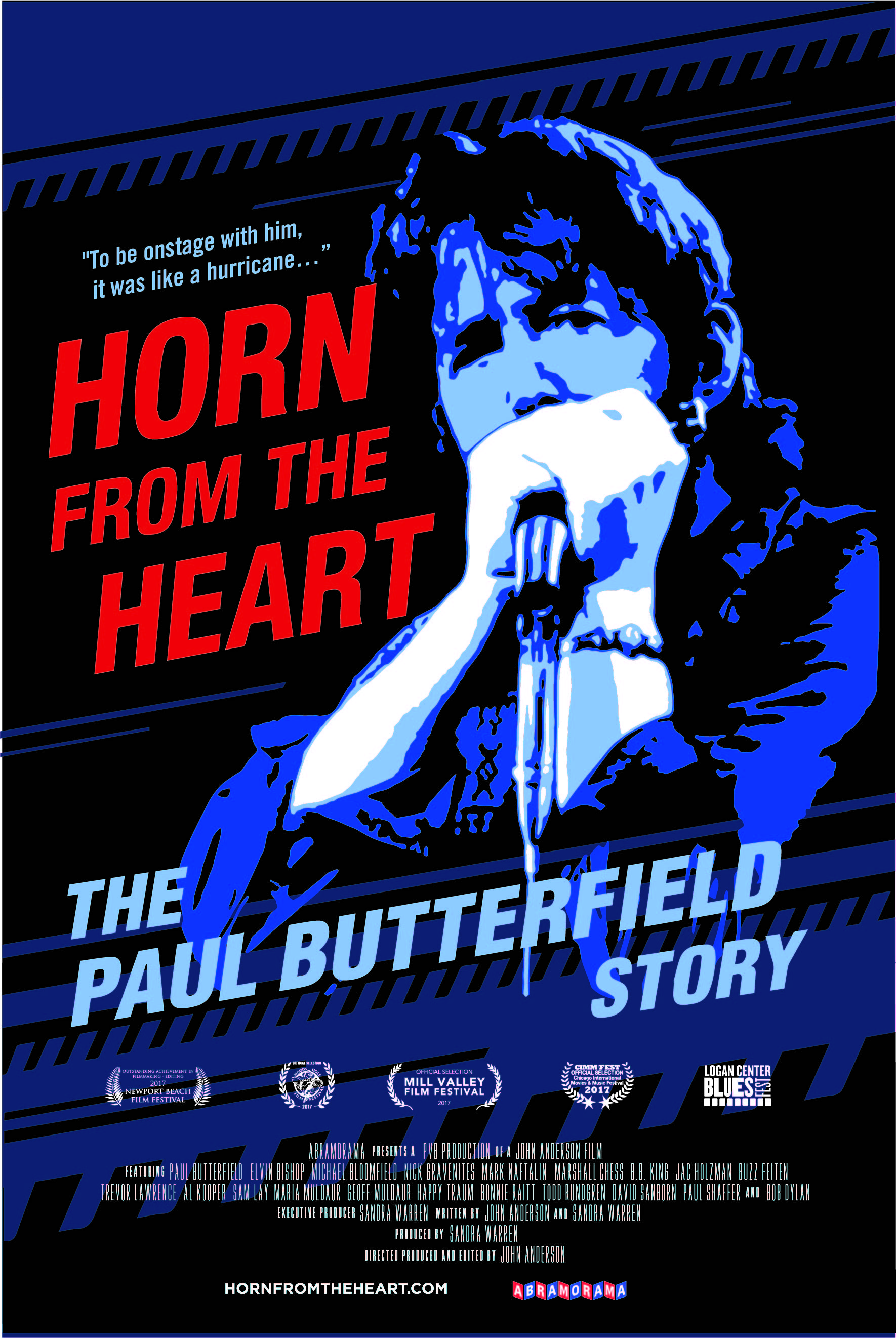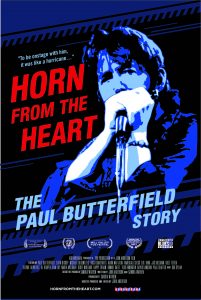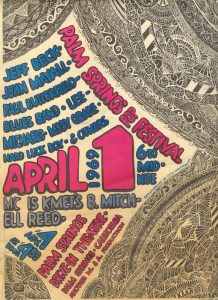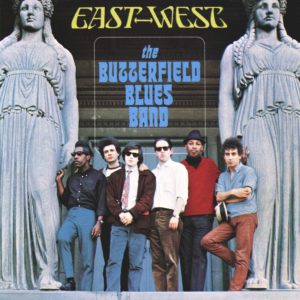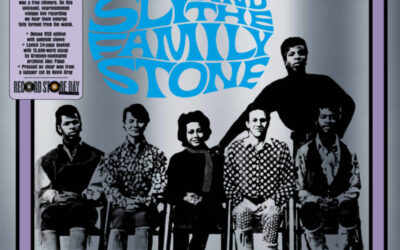Documentary Now Screening Across The U.S.
By Harvey Kubernik c 2018
Horn From The Heart: The Paul Butterfield Story is a feature-length documentary about the life and career of legendary blues musician
Paul Butterfield. A white, teenage harmonica player from Chicago’s South Side, Paul learned the blues from the original black masters performing nightly in his own back yard. Muddy Waters was Paul’s mentor and lifelong friend, happy to share his wisdom and expertise with such a gifted young acolyte.
The interracial Paul Butterfield Blues Band, featuring the twin guitar sound of Michael Bloomfield and Elvin Bishop, the rhythm section of Sam Lay and Jerome Arnold and the keyboards of Mark Naftalin, added a rock edge to the Chicago blues, bringing an authenticity to its sound that struck a chord with the vast white rock audience and rejuvenated worldwide interest in the blues. The band’s first LP, released in 1965, was named “#11 Blues Album of All Time” by Downbeat.
The only artist to perform at The Newport Folk Festival in 1965, The Monterey International Pop Festival in 1967 and the Woodstock Festival in 1969, Paul would continue to break new ground in the blues, and to stand up for racial equality, until his death at age 44 in 1987 of a drug overdose. Through his music and words, along with first-hand accounts of his family, his band mates and those closest to him, Horn From The Heart: The Paul Butterfield Story tells the complex story of a man many call the greatest blues harmonica player of all time.
The Paul Butterfield Blues Band was inducted into the Rock and Roll Hall of Fame in 2015. Paul Butterfield is one of a handful of musicians inducted into both the Rock and Roll and Blues Halls of Fame, alongside other legendary artists including B.B. King, Chuck Berry, Billie Holiday and Eric Clapton.
Horn From The Heart: The Paul Butterfield Story is a riveting documentary about his life, blues crusade and ill-fated career.
Butterfield, Elvin Bishop, David Sanborn, Bonnie Raitt, B.B. King, Maria Muldaur, Jac Holzman, Sam Lay, Mark Naftalin, Marshall Chess, Michael Bloomfield, Al Kooper, Nick Gravenites, Buzz Feiten, Happy Traum, Clydie King, Geoff Muldaur, Jim Kweskin, Corky Siegel, Barry Goldberg, Paul Shaffer, James Montgomery, Trevor Lawrence, Joe Boyd, Cindy Cashdollar, Todd Rundgren, Steve Madaio, Jim Rooney, and Bob Dylan are seen and heard in the movie.
The terrific film distributed theatrically by Abramorama, have booked U.S. screenings during the entire month of November. A DVD is planned for 2019.
For more information and additional screenings visit https://www.hornfromtheheart.com/
I interviewed Sandy Warren, the executive producer, producer, and co-writer about the mission behind Horn From The Heart The Paul Butterfield Story.
“As a young ‘folkie’ in the 60s who grew up with traditional folk music from the Pete Seeger songbook, my musical evolution took me to bluegrass music (such as The Greenbriar Boys); jug band music (such as Dave Van Ronk, the Ragtime Jug Stompers, and the Kweskin Jug Band); ‘traditional’ blues (such as Sonny Terry and Brownie McGhee); and to folk singers of the 60s, such as Phil Ochs, Joan Baez, Patrick Sky, Fred Neil early Donovan (Catch the Wind). I confess to having been among the folkie ‘snobs’ referred to by Maria Muldaur in Horn From The Heart, the purists who resisted music played on electric instruments.
“I used to buy a lot of records put out by Elektra – a label that released the folk music I was listening to – and one of them was the ‘sampler’ record called Folksong ’65. That record included tracks from Tom Rush, Judy Collins, Koerner, Ray & Glover, Hamilton Camp, Fred Neil, Phil Ochs and Tom Paxton. And incongruously, it also included Born in Chicago by The Paul Butterfield Blues Band.
“Of course, by 1965, music was exploding and beginning to define my generation. I was too young to go to the Newport Folk Festival that year, but I sure listened to Folksong ’65 and especially the Butterfield track. And after that, there was What’s Shakin’, another Elektra sampler with amazing music including The Lovin’ Spoonful, Al Kooper, Eric Clapton and more tracks from The Paul Butterfield Blues Band.
“There was no looking back. The electric blues played by The Paul Butterfield Blues Band captured me in a way that was different than the folk music I had been listening to. It was intense and pounding, totally immersive; sensual and challenging. For me, this opened up the musical floodgates. I listened to the first and then the second Butterfield records until they were so scratched up they popped and hissed. East-West was mind-blowing; it was a mesmerizing combination of rockin’ thumping electric blues and San Francisco trippy rock.
“By 1966-1967 I was listening to Cream, the Yardbirds, Ten Years After and other British electric rock bands; Hendrix; the San Francisco bands like Jefferson Airplane, Moby Grape and Country Joe and the Fish; and The Blues Project (I loved that band). But to my mind, Paul Butterfield was the guy who played electric blues first and opened up all these musical and other doors.
“I started going to Café Au Go Go around 1966 or 1967. Whenever the Butterfield band was playing there I was there too, after that same thing at the Filmore East. To this day, I think that the live performances by the Butterfield band are hard to surpass. Even the recordings, I think, didn’t quite capture the excitement and intensity of the live performances.
“Roll forward decades….I happened to meet some of Butterfield’s family in 2014, and the idea of making a documentary about him starting to grow. The more I learned about Butterfield’s life and the more I thought about his pivotal impact on rock and roll, the more I became convinced that his place in the history of pop music ought to be recognized and preserved. It seemed to me that he was disappearing into the dustbin of history. Because he died so young. And perhaps also because he did not self-promote, he spoke through his music and if you didn’t get it, so be it, he didn’t care. There is scant footage of him performing or even speaking, so his recordings and the memories of those of us lucky enough to have heard him live are his legacy. Thus this project was conceived and pursued.”
Sandy Warren enlisted director, editor and co-writer John Anderson to capture the artistic and troubled world of Paul Butterfield.
John Anderson and I discussed the endeavor.
“I saw Paul at The Atlantic City Pop Festival at 3 o’clock in the afternoon on August 2, 1969. The sheer power of his performance — he had the 5-piece horn section, including David Sanborn, Steve Madaio and Trevor Lawrence, all of whom are in the film and the last two of whom will be attending in LA — surpassed anything I’d ever heard. It was like an unstoppable train coming right at you for 60 minutes. It struck me how intensely focused Paul was on the music and the band. He said little between songs and had his back to the audience much of the time. All that mattered to him was the music, an attitude that left a big impression.
“In 2014 Corky Siegel was asked who might make the film and he recommended me.
“Having worked on Born In Chicago and Sam Lay In Bluesland over the previous six years, I had a basic understanding of the Paul story and knew many of the key players. Through phone conversations with Paul’s very generous friends, relatives and bandmates, the picture continued to fill in until we were able to determine who we needed to get on-camera, while keeping the main focus on the music.
“Given Paul’s worldwide renown, there’s remarkably little archival footage of him. He did few interviews and only a handful of complete live performances were committed to film or tape. David Hawkins at the blogspot The Complete Paul Butterfield http://paulbutterfield.blogspot.com/ was a tremendous resource.
“Paul’s ex-wife Kathy and his brother Peter and Peter’s family were very helpful in providing stills and in providing insight into this very humorous, talented and complex man.
“I love music and the number of great music docs produced in the last 15 years is encouraging and inspiring. We hope this film brings to light not only Paul’s importance to the history of popular music but also his key role in U.S. race relations in the 60s and 70s. And what he got out of that little thing, as Sam Lay says, ‘ain’t even on it.’”
I saw the group in the sixties. One time when they shared the stage with Lee Michaels, Procul Harum, The Flying Burrito Brothers and John Mayall at the April 1969 Palm Springs Pop Festival held three miles east of Palm Springs in Cathedral City at the Sunair Drive-In.
Michael Bloomfield wasn’t in that lineup but that outfit still delivered that very chilly night in the desert. The wail of Butterfield’s harmonica solos were haunting instrumental signals that were heard loud and clear by 8,000 people. Shortly afterwards there was a riot that spilled throughout Palm Springs all the way to Taquitz Falls Park.
In 1978 interviewed Michael Bloomfield for Melody Maker. I asked him about Butterfield and he told me “the one major thing that I learned from Paul was not to have any fear by watching him go further into the deepest sections of the south side Chicago world to see and play with the immortal bluesmen.”
I was present on a couple of commercial recording sessions Paul Butterfield was hired to play harmonica on during 1986-1987. He was battling some severe health issues at the time. The 1986 session was in Hollywood and the second in Malibu the day before he died in North Hollywood.
As this long overdue Butterfield documentary is booked across the U.S. the month of November, I felt it appropriate to ask some folks who saw Paul in action, met him, dug his band’s music and viewed this riveting cinematic portrait.
“I loved Dylan’s Highway 61 Revisited album. I loved Michael Bloomfield’s guitar playing on that album and loved Bloomfield on the first Paul Butterfield Blues Band album,” exclaimed Robby Krieger of The Doors.
“Bloomfield was my favorite for a while. To me he was the first white guy who could play blues better than the black guy. I liked East-West, the second Butterfield band LP, but the first one, oh my God…I wore the grooves out. He could play harmonica and I got to know him later in life. I was really excited when we signed to Elektra and Paul Rothchild was going to produce our first album and he had produced Paul Butterfield.”
“Their Elektra debut was the first ‘real’ blues album I ever owned, at age 13,” recalled Dr. James Cushing, a deejay on KEBF-FM. “I had it in mono! I grew five inches in height that year, and the melodies and chords from those songs settled into the bones and sinew of the person I was growing into. And the lyrics! Before I ever fell in with a girl, I knew that love could drift, that moneymakers could shake, and that last night a man lost the best friend he ever had. Paul Butterfield prepared me for adult life! At the same time, he prepared me for Muddy Waters, Howlin’ Wolf, Little Walter, Chess Records, and this vast, great tradition of American music.
“The title track of their second Elektra album, East-West, is a prime example of what I call Stealth Jazz — jazz improvisation played in a rock venue on rock instruments. ‘Spoonful’ by Cream, ‘King Kong’ by Zappa, ‘Machine Gun’ by Jimi, and ‘Flute Thing’ by the Blues Project are other examples, and so Butterfield prepared me for Kenny Burrell, John Coltrane, Miles Davis, and another vast, great musical tradition.
“The third Elektra album, The Resurrection of Pigboy Crabshaw, added horns and a soulful R&B coloration. A year later, he rejoined Mike Bloomfield on the Muddy Waters Fathers and Sons album for Chess, which closed the circle.
“I regret I never saw Butterfield live or met him. I did see Muddy Waters more than once, and I listen to blues regularly. This music is a part of my life, and that part is a great gift that Paul Butterfield gave me.”
“Horn From The Heart, such an appropriate title,” underscored Sarah Kramer, a trumpet player and horn arranger. “The way Paul played and sounded was like an electric horn. His tone, phrasing and dynamic energy brought forth so much power and was mesmerizing every time he played! I love all of the live footage in this film, and the mention of his mentors and fellow luminaries. That gear, the vintage amps and those microphones… the Bullet mic and the Pistol Grip, brought his already fierce playing to such heights. Truly, he lived and breathed that music, and brought together and integrated so many people through his passion, through their own passion.
“What a gift he was, and such a treat to have so many of his friends and family lay out portions of his journey. Having lived up in that area, I especially loved the footage and interviews from Woodstock and Bearsville and the clip of him with John Sebastian (whose father was also a harmonica master!). Don’t miss this film while it’s playing in a theater near you!”
In 1965 I interviewed Butterfield and he then played Massey Hall in Toronto on a Sunday night,” remembered Canadian-based writer Larry LeBlanc. “I knew all about Butterfield via Jim Delehant in Hit Parader who wrote continually about him. So they play the Massey hall show. Paul asks me where can we go for a drink. Toronto is closed down for liquor on Sunday night. Except for a few tourist designated areas. Sorta bullshit but there were a few. I knew one the Palm Grove Lounge. So Butters, Mike Bloomfield and organist Mark Naftalin grab a cab. At the club it’s a $5 charge. Paul pays for all. Performing is Chubby Checker. I kid you not. Mid-sized crowd in jackets and ties. We are all in hippie type clothing. Chubby is fucking incredible. We get nicely inebriated. Fun fucking evening. I worshiped Paul who could scare reporters. Not me. He was great. I was about 21 and I knew the blues. He was gracious and respectful. God bless anyone who messed with him though.”
“From folk festivals to blues festivals and rock concerts, The Paul Butterfield Blues Band played a pivotal part in the integration of blues, rock, and psychedelic music,” volunteered multi-instrumentalist David Kessel, who helms www.cavehollywood.com.
“The band played Chicago blues with a Jazz mentality that was really a needle and thread of the fabric of music going on at the time. Paul
Butterfield really took the blues harp into a dimension transformed from Little Walter. They were so ahead of their time that the album East-West came out a month before the Beatles Revolver album.”
“I was new to L.A. as I moved here in 1963 to attend a Junior College in the San Fernando Valley,” revealed record producer and blues advocate, Denny Bruce. “No car. Little by little I got to meet people, especially girls who were friendly to me because I had what was considered long hair.
“Two of my girlfriends loved all the new groups now happening. The Byrds were everywhere on Top 40 radio in 1965, and so were Sonny and Cher. I finally got to go into Hollywood with the girls, and we saw The Byrds. I was impressed with their songs and harmonies. The Byrds were the jingle jangle folk rockers thanks to ‘Mr. Tambourine Man,” they were hot.
“Nothing could have prepared me for my second trip to see The Byrds again at The Trip on Sunset Blvd.in January 1966. Because the group that opened for them, The Paul Butterfield Blues Band, were so no bull-shit wanna-be anything but who they were, a real blues band.
“They had an album out and the cover told you plenty,” underlined Bruce. “An integrated bunch of guys representing the rough edges of Chicago, home of Muddy Waters, Buddy Guy, Junior Wells and many more who all knew and respected The Paul Butterfield Blues Band.
“They had been playing electric blues since junior high school. Now it was business for them.
“I have never seen or heard a band with this kind of power playing songs I was soon to hear for a long time, as it was so real. Paul Butterfield was the lead singer, and harmonica player. He had command of the band, so when it was Mike Bloomfield’s time to play a solo it was because Paul nodded at him. Plus second guitarist, Elvin Bishop, could also solo. Mark Naftalin was the keyboard player who played perfect Chicago blues piano, as Otis Spann was his influence, as well as mentor.
“Their ensemble playing, with the harp, sounding like a much bigger band with a horn section,” disclosed Denny. “They did play kinda loud, but they had to, as it was part of the sound. When they left the stage it seemed very quiet in the club.
“The Byrds were set up and ready to start. They started and it sounded like college guys who just put away their acoustic guitar, and plugged in their new electric instruments.
“The Butterfield Band were men, and The Byrds now sounded like a bunch of boys. With a Bob Dylan song which was their silver platter welcome to become rock stars.
“In my humble opinion I wished that the PBB came back on and blew the roof off of this joint.
“I got to see The Butterfield Band play the Golden Bear in Huntington Beach a week later. Lines around the block. This time I went with two guys who knew the band. They were brilliant doing their thing in front of a packed house of blues lovers. They were so tight it felt as if the club was throbbing, like a big heart beat.
“The club owner told us he never has a band this good play here, and he has been doing this for a long time. He couldn’t explain it, but he loved it.
“That is what happens when music is real. You feel it.
“Bob Dylan knew he wanted to add something to his set at the Newport Folk Festival. And he knew Mike Bloomfield, Jerome Arnold and Sam Lay from The Paul Butterfield Blues Band were some of the right guys to help him turn up the heat when he ‘plugged in’ and helped change the direction of music, big time.
“Dylan’s Highway 61 Revisited album took him to the top of the pop charts with Michael Bloomfield’s wild slide guitar playing opening the door for blues rock to become a major fabric in what now made up the direction of acts being good studio players and even greater live acts.”
“During the 1967 Berkeley Folk Festival, I got a chance to hang out with members of the James Cotton Band including James himself,” stated multi-instrumentalist Chris Darrow. “James Cotton, to me, was the finest blues harmonica player alive at that time.
“One night, Jimmy Fadden, the harmonica player in the Nitty Gritty Dirt Band, and I, went to the Whisky A Go Go to see James Cotton play. Besides Jimmy, there was another famous player in the room, the great Chicago blues harpist, Paul Butterfield. Cotton, asked the two guys to join him up on stage and they had at it. They had a friendly ‘cutting session,’ in the old jazz terminology. The band played a blues groove and then they took their turn in succession, until they were all playing together. It was a once in a lifetime experience.”
During 2017 I conducted an interview with Jac Holzman, the founder and former owner of Elektra Records.
In viewing the Butterfield documentary we are reminded once again of Holzman’s bold A&R acumen in his signing of The Paul Butterfield Blues Band to his label. This is the man who initially made it possible for all of us to purchase these precious platters of Paul and Co. in retail outlets.
“I didn’t listen too much of what was going around me except to hear the most contemporary of things so that I could kind of avoid it.
“Because it’s like shooting a bird in the sky. If you want to shoot a bird you shoot ahead of the bird and the bird and buck shot gets there at the same time. So I always wanted to be out ahead and looking for things I hadn’t heard before,” explained Jac. “But there was a mood of those times. And the Summer of Love was also the summer of psychedelia and things of that nature.
“We did have Paul Butterfield, The Doors, we had Tim Buckley, Goodbye and Hello, which was a very emblematic of that time, and Love’s Forever Changes, their third album. But the whole label was me looking for something that I hadn’t heard before. Or something that I had heard but it had a new face on it or it felt intrinsically different to me.”
“I was the type of record collector that if I liked a cult label, such as Elektra, I would tend to buy everything they put out,” confessed Gene Aguilera, East L.A. music historian and boxing book author (Latino Boxing in Southern California, Arcadia Publishing).
“And this is how I found The Paul Butterfield Blues Band first LP, in the used bins of Platterpuss Records in Long Beach for $1.99. They were a young inter-racial band from the south side of Chicago that played the blues at a break-neck pace. They played it fast, loud, and electric.
“I discovered Michael Bloomfield through this LP, and always preached to anyone who would listen that he was the best white blues guitarist around. I really liked how Butterfield played the harp and shared the vocal mic with drummer Sam Lay; and how everything clicked with future star guitarists Michael Bloomfield and Elvin Bishop; and how these guys worshipped at the throne of Muddy Waters, Willie Dixon, and Robert Johnson. And that’s the bottom line of any blues band worth their salt.”
“There was a real buzz around Melbourne Australia about the Butterfield Blues Band’s debut album,” recollected writer and musician David N. Pepperell.
“It’s hard to say where that buzz came from as there wasn’t much music media available in town in 1965 yet it was all over that this was an album you had to have if you had any interest in the blues.
“Blues fans were a small coterie in those days, although growing day by day because of the influence of The Rolling Stones, and we all kind of knew each other from social gatherings and Blues records nights at various people’s houses.
“Elektra did not have a local record company licensee at that time and we soon found that the only place to get the Butterfield’s record was at a shop called Discurio run by Peter Mann who had somehow got a deal to bulk import Elektra records into Australia.
“Amazingly he had started a list of people wanting the album and I put my name down, not really knowing anything about the record except it was going to ‘shake the world.’
“The idea of young white Americans playing authentic blues was an exciting one and we all wondered how good the Butterfield Blues Band could be,” confessed Pepperell.
“Finally I got a phone call from Peter saying my record was there, rushed into town, picked it up, rushed back home and put it on the turntable. From the opening harmonica trills of ‘Born In Chicago’ I was totally hooked. Paul B. was a knockout singer and harp player and the guitarist in the band, the then unknown to me Mike Bloomfield, seemed to have every blues guitar lick there was completely nailed down.
“I had the original versions of many of the songs – ‘Shake Your Moneymaker,’ ‘Blues With A Feeling,’ ‘Got My Mojo Workin’, ‘Mellow Down Easy’ – but I loved the way Butterfield performed them with so much energy and passion, plus a band that rocked its socks off.
“What a record that was!
“The band originals all fitted into the mix along with the blues classics making it a totally remarkable, vibrant piece of work and I must have played it about ten times straight before I stopped for a break.
“I was singing in a sort of bluesy band at that time but we didn’t sound anything like the Butterfields – more like a poor man’s Rolling Stones I think now – and to hear them wailing with all that authenticity was just mind boggling.
“Very few albums in my lifetime hit me like that the first time I played them and I still get a chill down my spine when I listen to the Paul Butterfield Blues Band even now.
“Regrettably neither the band not Paul ever toured Australia because they had thousands of fans here who would have given an arm, and maybe even a leg too, to see them,” sighed Pepperell.
“Still their records live on but their first album was a major event in my life and continues to be so. When John Mayall’s Bluesbreakers, with a young Eric Clapton on lead guitar, released their eponymous album in 1966 it was another magic moment but it could not compete with Butterfield and Bloomfield and Naftalin and Bishop and Lay and Arnold – they were as good as it could get!
“Horn From The Heart was a really fine documentary and told me so much I didn’t know about Butterfield.”
“At the 1967 Monterey International Pop Festival I saw The Paul Butterfield Blues Band,” happily marveled Chris Hillman of The Byrds. “We had worked with Paul the one time when the Byrds really came to the plate. Which when we did a week [January 1966] at The Trip [in Hollywood] and Butterfield’s original band and they were so good. Smoking. Michael Bloomfield doing answer solos with Butterfield on harmonica. They were so good and the Byrds…
“The one time in our whole career that we played every night at our peak. It wasn’t a competition. It was two different kinds of music. We went ‘Oh my God. We played good.’ That was when the Byrds really jelled and really got together that week at The Trip. There were other times, but I always remember that so distinctly. Butterfield. Great band. I studied that first album. I got to know him a little bit,” said the acclaimed singer/songwriter.
“I remember doing a music festival with him in 1969 in Palm Springs, with The Burrito Brothers. I remember walking with Paul to the promoter’s tent with Paul Butterfield, and he’s got his brief case with a 38 Colt piece in it, and I said to myself, ‘This guy really did work on the south side of Chicago. Oh…Here we are in the peace and love bull shit and here he’s got his 38 loaded to go and collect his money!’ This guy is real. A real blues guy!”
(Harvey Kubernik is the author of 15 books, including titles on Leonard Cohen and Neil Young. His 2017 volume, the acclaimed 1967 A Complete Rock History of the Summer of Love was published by Sterling/Barnes and Noble. His Inside Cave Hollywood: The Harvey Kubernik Music InnerViews and InterViews Collection, Vol. 1 was published in December 2017, by Cave Hollywood. Kubernik’s The Doors Summer’s Gone was published by Other Cottage Industries in March 2018.
In November 2018, Sterling/Barnes and Noble published Harvey’s book, The Story of The Band From Pig Pink to The Last Waltz, written with brother Kenneth Kubernik). In November
Of 2006, Harvey Kubernik was a featured speaker discussing audiotape preservation and archiving at special hearings called by The Library of Congress and held in Hollywood, California).

